Al Ain
| Al-‘Ain الْـعَـيْـن (in Arabic) | |
|---|---|
| city | |
| Al Ain, United Arab Emirates | |
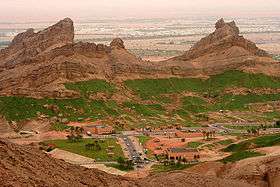 A view over Green Mubazarrah in Al-Ain | |
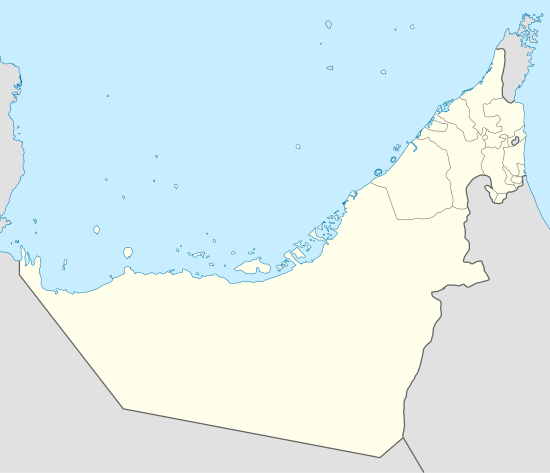 Al-‘Ain Location of Al Ain in the UAE | |
| Coordinates: 24°12′27″N 55°44′41″E / 24.20750°N 55.74472°ECoordinates: 24°12′27″N 55°44′41″E / 24.20750°N 55.74472°E | |
| Country | United Arab Emirates |
| Emirate | Abu Dhabi |
| Subdivisions |
|
| Government | |
| • Type | Municipality |
| • Sheikh | Khalifa bin Zayed Al Nahyan |
| • Ruler's Representative of the Eastern Region of the United Arab Emirates | Tahnoun bin Mohammed Al Nahyan |
| Area | |
| • Total | 15,100 km2 (5,800 sq mi) |
| Elevation | 292 m (958 ft) |
| Population (2017) | |
| • Total | 766,936, |
| • Density | 51/km2 (130/sq mi) |
| Time zone | UTC+4 (UAE Standard Time) |
| UNESCO World Heritage site | |
| Official name | Cultural Sites of Al Ain (Hafit, Hili, Bidaa Bint Saud and Oases Areas) |
| Criteria | Cultural: iii, iv, v |
| Reference | 1343 |
| Inscription | 2011 (35th Session) |
Al-‘Ain (Arabic: اَلْـعَـيْـن, al-ʿayn, literally The Spring) is a city in the Emirate of Abu Dhabi, the United Arab Emirates. Located on the border with Oman, it is also known as the "Garden City of the Gulf" due to its greenery, particularly with regard to the city's oases, parks, tree-lined avenues and decorative roundabouts, with there being strict height controls on new buildings, to no more than four floors. It is the largest inland city in the United Arab Emirates, the fourth-largest overall (after Dubai, Abu Dhabi, and Sharjah), and the second-largest in the Emirate of Abu Dhabi. The freeways connecting Al-Ain, Abu Dhabi, and Dubai form a geographic triangle in the country, each city being roughly 130 kilometres (81 mi) from the other two. Al-Ain was where Sheikh Zayed bin Sultan Al Nahyan, the founder of the United Arab Emirates, spent much of his life, after moving here from his birthplace of Abu Dhabi in 1927.[1][2]
Climate and geography
Al-Ain is located in the eastern region of Abu Dhabi Emirate, approximately 160 kilometres (99 mi) east of the capital Abu Dhabi, and about 120 kilometres (75 mi) south of Dubai.[3] The Eastern region covers an area of approximately 13,100 km2 (5,100 sq mi). Oman lies to the east, Dubai and Sharjah to the north, Abu Dhabi to the west and the Empty Quarter desert and Saudi Arabia to the south. The topography of Al-Ain is unique and varies as one travel to the east. Jebel Hafeet (Arabic: جَـبَـل حَـفِـيـت, "Mount Hafeet") is considered one of the monuments of Al-Ain, lying just to the southeast and rising to 1,300 m (4,300 ft) in elevation. Sand dunes of varying texture that are tinged red with iron oxide lie to the north and east of Al-Ain.
The city has a hot desert climate (Köppen climate classification BWh), featuring long, extremely hot summers and warm winters. In Al-Ain, the mean annual rainfall is 96 mm (3.8 in) and the average relative humidity is 60% (United Arab Emirates University, 1993). Low humidity in Al-Ain, particularly during the summers, makes it a popular destination for many people at that time of year. Boer (1997) classified the UAE climate as hyper-arid and divided it into four climatic regions: the coastal zone along the Persian Gulf, the mountain areas northeast of UAE, the gravel plains around Al-Ain area, and the central and southern sand desert. More rainfall and lower temperatures occur in the northeast than in the southern and western regions. The monthly average rainfall around Al-Ain was 100–120 mm (3.9–4.7 in) from the period 1970 to 1992.
| Climate data for Al Ain International Airport (1995–2017) | |||||||||||||
|---|---|---|---|---|---|---|---|---|---|---|---|---|---|
| Month | Jan | Feb | Mar | Apr | May | Jun | Jul | Aug | Sep | Oct | Nov | Dec | Year |
| Record high °C (°F) | 31.8 (89.2) |
36.6 (97.9) |
42.9 (109.2) |
44.4 (111.9) |
49.3 (120.7) |
49.0 (120.2) |
49.2 (120.6) |
48.8 (119.8) |
47.8 (118) |
43.1 (109.6) |
37.5 (99.5) |
35.0 (95) |
49.3 (120.7) |
| Average high °C (°F) | 24.8 (76.6) |
27.5 (81.5) |
31.5 (88.7) |
37.0 (98.6) |
42.2 (108) |
44.6 (112.3) |
44.9 (112.8) |
44.6 (112.3) |
41.9 (107.4) |
37.7 (99.9) |
31.5 (88.7) |
26.9 (80.4) |
36.3 (97.3) |
| Daily mean °C (°F) | 18.4 (65.1) |
20.6 (69.1) |
24.1 (75.4) |
29.0 (84.2) |
33.7 (92.7) |
35.9 (96.6) |
37.0 (98.6) |
37.1 (98.8) |
34.2 (93.6) |
30.3 (86.5) |
24.8 (76.6) |
20.3 (68.5) |
28.8 (83.8) |
| Average low °C (°F) | 12.7 (54.9) |
14.4 (57.9) |
17.3 (63.1) |
21.5 (70.7) |
25.5 (77.9) |
27.8 (82) |
30.0 (86) |
30.5 (86.9) |
27.4 (81.3) |
23.6 (74.5) |
18.9 (66) |
14.7 (58.5) |
22.0 (71.6) |
| Record low °C (°F) | 5.6 (42.1) |
5.9 (42.6) |
9.9 (49.8) |
13.2 (55.8) |
18.0 (64.4) |
20.9 (69.6) |
22.8 (73) |
21.9 (71.4) |
21.8 (71.2) |
16.2 (61.2) |
13.0 (55.4) |
7.4 (45.3) |
5.6 (42.1) |
| Average rainfall mm (inches) | 11.6 (0.457) |
4.7 (0.185) |
19.1 (0.752) |
5.9 (0.232) |
0.7 (0.028) |
0.7 (0.028) |
5.5 (0.217) |
1.6 (0.063) |
0.9 (0.035) |
0.6 (0.024) |
1.7 (0.067) |
8.3 (0.327) |
61.3 (2.413) |
| Average relative humidity (%) | 63 | 55 | 48 | 36 | 30 | 33 | 37 | 35 | 39 | 43 | 53 | 61 | 44 |
| Source: National Center of Meteorology[4] | |||||||||||||
Demographics
With a population of 766,936 (as of 2017),[5] it has the highest proportion of Emirati nationals (30.8%) in the country, though the majority of its residents are expatriates, particularly from the Indian subcontinent. Many people are from Bangladesh and Pakistan, and a huge number of Afghans are from the province of Khost.[6]
Economy

Al-Ain is an important services centre for a wide area extending into Oman. There are three major shopping centres, Al Ain Mall, Al Jimi Mall and Al Bawadi Mall (opened in 2009 in Al Khrair area) as well as traditional souqs for fruit and vegetables and livestock. Industry is growing, but is still on a small scale, and includes the Coca-Cola bottling plant and the Al-Ain Portland Cement Works. The water in Al-Ain is of good quality. Service industries such as car sales, mechanics and other artisans are located in the area known as Sanaiya and Pattan Market. Social and governmental infrastructure include the Higher Colleges of Technology, well-equipped medical facilities including the teaching hospital at Tawam, military training areas and Al Ain International Airport.
History
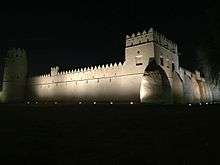
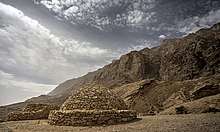
Historically a part of Ṫawam or Al Buraimi Oasis. Al-Ain has been inhabited for over 4,000 years, with archaeological sites showing human settlement at Al-Hili and Jabel Ḥafeeṫ. These early cultures built "beehive" tombs for their dead and engaged in hunting and gathering in the area. The oasis provided water for early farms until the modern age.
A companion of the Islamic Nabī (Arabic: نَـبِي, Prophet) Muhammad, Ka‘ab Bin Ahbar, was reportedly sent to the region to introduce Islam to the people. He settled and died in the oasis.[7]
The forts currently in Al-Ain were built in the late 19th or early 20th century to solidify Abu Dhabi's control over the oasis. Wilfred Thesiger visited Al-Ain in the late 1940s, during his travels across the Empty Quarter. He met Sheikh Zayed and stayed with him at Al-Muwaiji Fort. This network of fortresses protected the Oases and settlements from bandit attacks. In 1952, Saudi Arabia sent raiders to capture Al-Ain's fortresses and incorporate the oasis into the Saudi kingdom. Forces from the Trucial Oman Scouts, as well as the army of Muscat-Oman, arrived to recapture the oasis. With British intervention, the Saudi forces surrendered, leaving the oasis back in the hands of Abu Dhabi and Muscat-Oman.
In 1971, Queen Elizabeth II visited the Hilton Hotel in the area, still in use, during her tour of the Persian Gulf. Following independence in 1971, Al-Ain experienced rapid growth and investment as part of the emirate of Abu Dhabi, quickly becoming larger and more successful than Oman's Al-Buraimi. In 1972, Oman and Abu Dhabi agreed on the final borders to divide Al-Buraimi and Al-Ain. Until Sheikh Zayed's death in 2004, Al-Ain's municipal code forbade construction of buildings over four storeys, with the exceptions of the Hilton, Danat Al Ain Resort, and Rotana hotels.
In the 1990s, a serious uprising occurred among the labourers of the industrial district of Al-Ain, Aṣ-Ṣana‘iya. This uprising was suppressed by the UAE army and local police forces. All the labourers involved were interned and deported.
Until 2006, Al-Buraimi and Al-Ain shared an open border. This border was closed in November 2006, and passport controls were imposed.
Oases
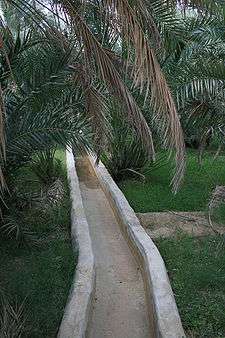
The city's oases are known for their underground irrigation system (falaj[8] (Arabic: فَـلَـج) or qanāṫ Arabic: قَـنَـاة)) that brings water from boreholes to water farms and palm trees. Falaj irrigation is an ancient system dating back thousands of years, and is used widely in Oman, the UAE, China, Iran and other countries.[9][10] There are seven oases here. The largest is Al Ain Oasis,[11][12][13] near Old Sarooj, and the smallest is Al-Jahili Oasis. The rest are Al Qattara, Al-Mu‘ṫaredh, Al-Jimi, Al-Muwaiji, and Al-Hili.
Infrastructure
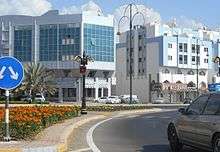
The city is known for its combination of modern and pre-modern buildings. The latter offer an insight into the city's and country's cultural heritage.[8]
Education
Al-Ain is home to the main federal university in the UAE, the United Arab Emirates University, and to two campuses of the Higher Colleges of Technology - Al Ain Men's College and Al Ain Women's College. Al-Ain is also the home of Horizon International flight academy, Etihad Airways's cadet pilot training centre. Private higher education institutions include the Al Ain University of Science and Technology and Abu Dhabi University (Al-Ain campus). Al-Ain also houses the eastern zone headquarters of the Abu Dhabi Education Council, Abu Dhabi's education authority.
Many of Al-Ain's private schools, catering mainly to the expatriate population, are located in the Al-Manaseer area. They include Al-Ain International school (British curriculum, private school, part of the Aldar group), Al Ain English Speaking School, Al Dhafra Private School, Manor Hall School, Al-Sanawbar School, Liwa International School, Al-Madar International School, Global English School, Emirates Private School, a branch of the International School of Choueifat, and an Institute of Applied Technology campus. Other private schools include the CBSE affiliated school Indian School, Al-Ain, Our Own English High School,Al Adhwa Private School, and Al Ain Juniors School.
Al-Khwarizmi International College has started a Campus at Al-Ain and is offering BBA programme and various other licensed, accredited and approved courses.
Health

The first hospital in Al-Ain was Oasis Hospital, established in 1960 at the invitation of Sheikh Zayed. Oasis serves all nationalities, and provides training for medical students from UAE University. Ground has been broken for a new hospital to be completed in 2011.[14] The hospital is part of CURE International.
Al-Ain is the home of Tawam Hospital, a training and research hospital linked with the UAE University. It was officially inaugurated on 17 December 1979. In March 2006, Johns Hopkins Hospital (Johns Hopkins Medicine International) (JHMI) took over the management of Tawam hospital.
Al Ain Hospital (abbr: AAH, also known as Al-Jimi Hospital) is the general hospital delivering health services to all Al-Ain patients regardless of their nationality. It is centrally located in the Al-Jimi district and is linked with the UAE University. Al-Ain Hospital still occupies old 1970s buildings, but a new building is planned. AAH currently has about 450 beds and provides services in all medical disciplines. In September 2007, the Medical University of Vienna International[15] (MUVI) took over the management of AAH.
Places of worship
Currently, the city's largest mosque is that of Shaikha Salamah.[16] Once the under-construction Sheikh Khalifa Bin Zayed Al Nahyan Mosque is complete, it is expected to be the largest in the city, and one of the biggest mosques in the country.[8][17]
Tourism and recreation
Al-Ain is developing as a tourist destination. The dry desert air makes it a welcome retreat from the coastal humidity of the larger cities. Many Emirati nationals in Abu Dhabi have holiday houses in the city making it a popular weekend destination for families from the capital city. Its attractions include the Al Ain National Museum,[18][19] the Al Ain Palace Museum, several restored forts and the Hili Archaeological Park site, dating back to the Bronze Age. Jebel Hafeet, a mountain measuring 1,340 metres (0.83 miles), dominates the surrounding area. It is popular to visit to the mineral springs at the base and to drive to the mountaintop at sunset. Other attractions include the Al Ain Oasis in the city centre, other oases dotted around the area — all cool retreats in the middle of the summer heat — Al Ain Zoo, an amusement park named "Hili Fun City", many well-maintained parks popular with families in the summer evenings, and a heritage village. Opened in 2012, Wadi Adventure is located near Jebel Hafeet and provides a range of water-based activities including surfing, kayaking and rafting. On top of Jabel Hafeet is the Mercure Hotel.
Al-Ain has five major malls — Al Ain Mall in the town centre, Al-Jimi Mall in Al-Jimi District, Bawadi Mall in Al-Khrair District, Remal Mall located in the Sanaiya district, and Hili Mall located in the Hili District. Most commercial activity is centred in and around town centre.
Another popular pastime for Emiratis and expatriates alike is spending time in coffee shops and shisha cafes. There are many Café's in Al-Ain, ranging in size and quality.
Al-Ain also has an International standard go-kart circuit. Al-Ain Raceway was selected to host the 2007 Rotax Max World Karting Finals, an event which saw 220 drivers from over 55 different countries compete for the Karting world title. Al-Ain Raceway opened to the general public in May 2008 and proves a popular activity for local Emiratis and tourists alike. It was announced in late 2010 that the 2011 Rotax Max World Karting Finals will be held at Al-Ain Raceway, this will bring nearly 1000 tourists to the small garden city.
Like the rest of the UAE, Al-Ain has strict laws governing the consumption and distribution of alcohol. Five facilities in the city currently serve alcohol, Four of which are hotels. Al-Ain Rotana, Hilton, Mercure Grand Jebel Hafeet and Danat Al-Ain Resort, hotels all have pubs, bars, or night clubs. In addition to the hotels, the Al Ain Equestrian, Shooting & Golf Club[20] in Al-Maqam also serves alcohol.
Currently, there are only four locations that sell alcohol for private use — Spinneys near Al-Jimi District, an outlet to the left of the Hilton hotel (next to the hotel's staff quarters), High Spirits Bottle Shop behind Lulu Hypermarket Sana‘iya and the North Africa Market in Sanaiya.
The city has two English-language radio stations — 100.1 Star FM, which plays English-speaking hits alternating with Arabic-speaking hits, and 105.2 Abu Dhabi Classic FM, which plays classical music.
Sport, culture, and arts
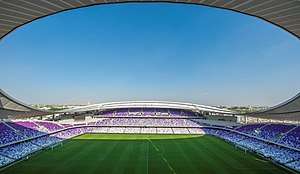
Al-Ain is a cultural retreat for residents of the cities of Dubai and Abu Dhabi. It is home to a major festival of classical music, and is the home of Al Ain Club, which is one of the most successful football clubs in the UAE and Asia.[21] It has many titles and championships to its name.[22] Al-Ain Club contains also eight other games which are: handball, volleyball, basketball, swimming, Table Tennis, Athletics, Jiu jitsu, and Taekwondo.
Hili Fun City hosts two ice hockey teams, the Al Ain Vipers[23] and Ghantoot. Each team has adult and youth teams starting from age 4. The Al-Ain Vipers Men's Team won the Emirates Hockey League in the 2009-10 season.
The Palm Resort to the west of the town hosts a popular rugby club with adult and youth teams, and the Al-Ain International Soccer Club which has three youth teams, including one for 7-9 year old's. There is a water sports centre called "Wadi Adventure", with a wave pool and surf instructors. Additionally, the park has facilities for kayaking and rafting on an artificial river.
Gallery
 Aerial view of the city of Al-Ain, from the top of the Sheikha Salama Mosque, with Jabal Hafeet in the background
Aerial view of the city of Al-Ain, from the top of the Sheikha Salama Mosque, with Jabal Hafeet in the background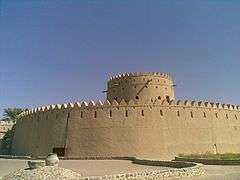 Al-Hili Tower
Al-Hili Tower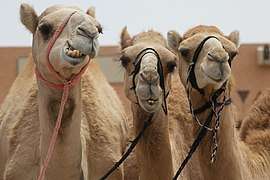
.jpg) The main office of the Emirates Telecommunication Group Company
The main office of the Emirates Telecommunication Group Company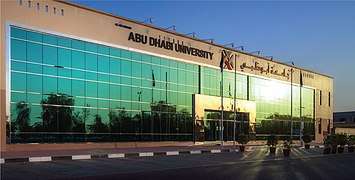 The Abu Dhabi University Campus in Al Ain
The Abu Dhabi University Campus in Al Ain Mercure Hotel built near the top of Jebel Hafeet
Mercure Hotel built near the top of Jebel Hafeet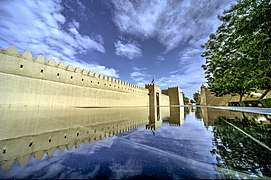 Qasr Al Muwaiji in Al Ain is the birthplace of the current President of the UAE Sheikh Khalifa bin Zayed Al Nahyan
Qasr Al Muwaiji in Al Ain is the birthplace of the current President of the UAE Sheikh Khalifa bin Zayed Al Nahyan
See also
References
- ↑ Martin, Douglas (3 November 2004). "Zayed bin Sultan, Gulf Leader and Statesman, Dies". The New York Times. Archived from the original on 30 July 2013. Retrieved 25 January 2014.
- ↑ "The legacy of Sheikh Zayed bin Sultan Al Nahyan, Father of the UAE". AMEinfo.com. 2 November 2004. Archived from the original on 29 April 2013. Retrieved 18 April 2013.
- ↑
- ↑ "Climate Normals for Al Ain I.A for the period from 1995 to 2017". National Center of Meteorology. Archived from the original on 20 February 2018. Retrieved 20 February 2018.
- ↑ "Abu Dhabi population hits 3 million, fertility rate up to 3.7 per citizen-female - Inter Press Service". www.ipsnews.net.
- ↑ "Afghan city reflects expats' trust in young democracy, says envoy".
- ↑ "Hazrat Subhan Qadri at Mazar e Mubarak Hazrat Kaab Bin Ahbar RA and other Companions, Al-'Ain, UAE". YouTube. 20 February 2011. Retrieved 22 April 2013.
- 1 2 3 Leech, N. (2017-03-06). "Magical history tour of Al Ain". The National. Retrieved 2018-04-02.
- ↑ Wilson, A. (2008). "Hydraulic Engineering and Water Supply". In John Peter Oleson. Handbook of Engineering and Technology in the Classical World (PDF). New York: Oxford University Press. pp. 290–293. ISBN 978-0-19-973485-6. Archived from the original (PDF) on 7 November 2017. Retrieved 1 November 2017.
- ↑ Goldsmith, Edward. The qanats of Iran. Archived from the original on 2012-01-14.
- ↑ "واحة العين", VisitAbuDhabi.ae (in Arabic), retrieved 2018-03-28
- ↑ "واحة العين مجمع التاريخ وملتقى الجمال". Al-Khaleej (in Arabic). 2014-09-04. Retrieved 2016-10-12.
- ↑ An oasis in the heart of Al Ain, UAE Interact, 10 October 2005, archived from the original on 23 February 2017, retrieved 23 February 2017
- ↑ "Oasis Hospital | About Oasis". oasishospital.org. Retrieved 2018-03-11.
- ↑ Medical University of Vienna.
- ↑ "Sheikha Salama Mosque", APG, retrieved 2018-04-01
- ↑ Abdul Kader, B. (2014-10-31). "Al Ain to have one of the largest mosques in UAE". Gulf News. Retrieved 2018-04-02.
- ↑ "Al Ain National Museum". VisitAbuDhabi.ae. Retrieved 2017-08-06.
- ↑ "Museum and archaeological park for Abu Dhabi". Past Horizons. Archived from the original on 2012-03-06. Retrieved 2013-12-21.
- ↑ "Al Ain Equestrian, Shooting & Golf Club". www.aesgc.ae.
- ↑ "AFC Champions League 2002/2003 Results - Asia Soccer". www.soccer24.com. Retrieved 21 April 2016.
- ↑ "الأهلي يستعيد أمجاد العـــقد الأول.. والعين "زعيم" بـ 58 لقباً". الإمارات اليوم (in Arabic). 9 April 2014. Retrieved 21 April 2016.
- ↑ alainvipers.com Archived 17 October 2015 at the Wayback Machine.
External links
| Wikivoyage has a travel guide for Al Ain. |
| Wikimedia Commons has media related to Al Ain (Abu Dhabi). |
.jpg)